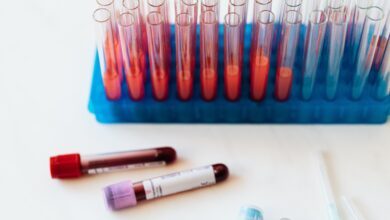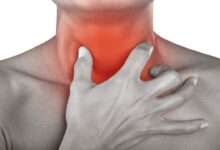
Food allergy: preventive measures
Can food allergies be prevented?
The medical community is exploring various avenues of prevention that could be of interest to parents themselves suffering from a form of allergy, whether food, respiratory or skin, and who wish to reduce the risk that their child is also allergic.
Currently, the majority of allergists agree to recommend:
- no exposure to second-hand smoke in children and no smoking in adolescents;
- exclusive breastfeeding up to 4 to 6 months;
- introduction of solid foods according to the schedule drawn up by the paediatricians.
Other preventive means are controversial. These are hypotheses that remain to be validated.
Delay the introduction of potentially allergenic foods in children (fish, eggs, peanuts, etc.)
The idea is to give the baby the least allergenic foods first. According to the Quebec Association of Food Allergies, however, it has not been proven that this practice reduces the risk of allergy.
In general, doctors recommend introducing foods one at a time and watching for any abnormal reactions. In addition, if we wait until the child is old enough to verbally describe his discomfort, we have more possibilities of detecting possible allergies.
Consuming more omega-3s during pregnancy
Researchers estimate that the high presence of omega-6 in the diet (and consequently, the low presence of omega-3) could contribute to increasing the frequency of allergies of all kinds in modern societies.
Omega-6 would make the body more sensitive to allergens and cause inflammation. Various studies have evaluated the effect of eating fatty fish or taking fish oil supplements during pregnancy, breastfeeding or early childhood on the onset of allergies in children.
According to a summary of studies, the most convincing data relate to the consumption of fish during pregnancy . A study conducted during breast-feeding showed no protective effect. For the rest, the results are contradictory.
Follow a hypoallergenic diet while breastfeeding
This fairly restrictive diet requires avoiding the main allergenic foods, such as cow’s milk, eggs and nuts, in order to avoid exposing the infant.
Note that 2 meta-analyses by the Cochrane group have concluded that this practice reduces the risk of atopic eczema in children9,18. This has been demonstrated with women who were at risk of having an allergic child (they or their spouse suffered from allergies).
The decision whether or not to follow such a diet is made on a case-by-case basis. The follow-up of such a diet must be done under the supervision of a health professional in order to avoid nutritional deficiencies in the mother.
Contraindication: this diet is contraindicated during pregnancy: it does not reduce the risk of allergy in the child and risks causing malnutrition problems in the mother and the fetus9.
Measures to avoid exposure to allergenic foods
Preventing allergic reactions requires constant vigilance. Finally, very small amounts of food can cause allergic reactions.
Inform those around the allergic person
The more the entourage is well informed of the child’s allergy and the measures to be taken in the event of a reaction, the better the child is protected. The entourage includes siblings, extended family, school staff, friends, parents of friends, etc.
Wear a MedicAlert® bracelet
This bracelet indicates the nature of the food allergy. It informs those around you and is very useful in an emergency.
Monitor and decode ingredient lists
The allergenic food can be found as an ingredient in a host of food products. Allergenic proteins can indeed have several names. There are about thirty for the egg (for example, livetin, lecithin and albumin), and more for milk and soy.
In addition, you can find ingredients that you would not expect in some prepared products, such as dairy products in deli meats or fish in barbecue sauce (Worcestershire sauce contains anchovies).
We should mention that peanuts, almonds, cow’s milk and eggs are the only allergens for which we have recognized detection methods. In Quebec, the Certified Allergen Control Program, launched by the Quebec Association of Food Allergies in 2006, offers an independent assessment of products certified free of any of these allergens.
See the Sites of Interest section to learn more about this program.
It is important not to consume products that “may contain traces” or “contain traces” of the allergen in question. It is useful to know that, for the moment, the Canadian and French regulations in terms of labeling do not oblige the agri-food industries to display this mention.
In addition, it happens that there are slight variations in the composition of a product from one batch to another, or that the recipes are modified. With prepared foods, you have to learn to manage the risk. Chocolate, cookies and breakfast cereals are most likely to contain traces of peanuts.
Identify dishes correctly
In order to avoid any confusion, the dishes intended for the allergic person should be clearly identified.
Eliminate sources of contamination
In many cases, allergic reactions are caused by the indirect ingestion of an allergenic food, through a contaminated food or kitchen utensil, for example.
How can this risk of contamination be reduced?
- At home, use different utensils for preparing meals;
- check the cleanliness of the dishes before using them;
- reheat dishes separately for the allergic person. Allergenic proteins can indeed be found in the cooking steam of a dish;
- avoid bulk foods. Contamination is frequent between the different foods offered in bulk. Consider, for example, sunflower seeds contaminated with nuts, or bulk candy contaminated with peanuts.
Restaurants, trips, buffets
These situations increase the risk of unwitting exposure to allergenic foods. More attention is needed. By choosing the least processed foods possible, the risk of being exposed to the allergen is reduced.
Schools and other public places
They should have emergency plans in place to know how to react quickly in the event that a person has a serious allergic reaction. In order to reduce the risk of contamination in kitchens and cafeterias, training is offered to staff.
No treatment can eliminate a food allergy.
To find out more, see our fact sheet on treatments below.














